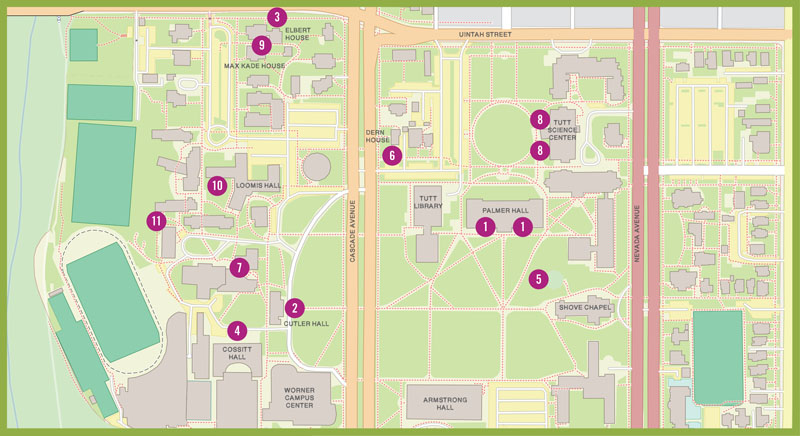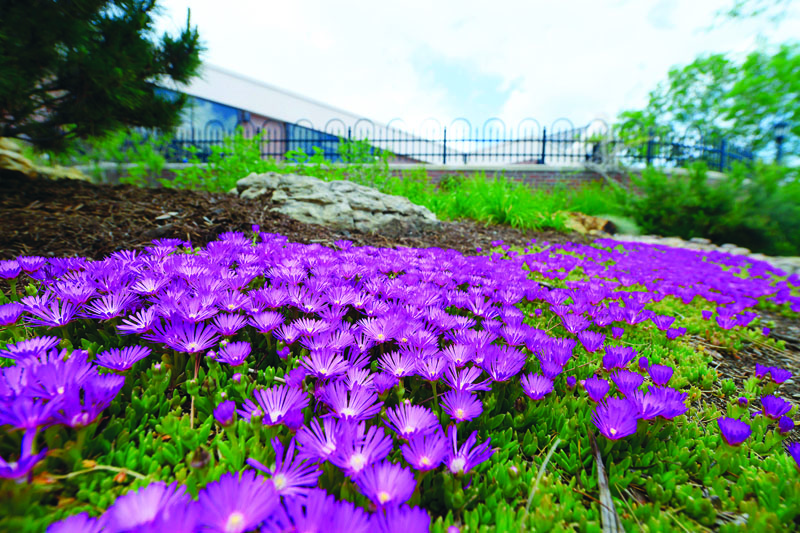“If you have a garden and a library, you have everything you need.”
– Marcus Tullius Cicero, “Letters to His Friends, Vol 2: Books 7-12”
According to Cicero, Colorado College must be a very special place indeed. CC is lucky to have both a library (soon to undergo a major renovation and expansion) and many beautiful gardens, some tucked behind buildings, some front and center, gracing the road median or the quad.
There are approximately 20 separate gardens on campus, not counting the many shrub beds maintained.
While campus beautification is a worthy goal in itself, the gardens bring more than mere beauty to the college community and the visitors who wander through and appreciate them.
They are instrumental in creating on campus a sense of place; the idea that this location in the world is unique unto itself, but that it also reflects and respects the larger natural landscape and ecosystem that it inhabits.
The gardens are also important as a teaching tool, used by students and professors in many classes and by the community as a living example of how native, adapted, and drought-tolerant plants can be used in the landscape.
All these ideas are prescribed in the campus master plan, which after almost a year and a half of work and collaboration was recently finalized and is available online at 2cc.co/ccmasterplan
The campus master plan provides guidance for the next 30 years on priorities for campus development, while at the same time identifying potential opportunities for improvements to the campus. The Board of Trustees approved the plan at its February 2015 meeting.
The master plan also calls for the stewards of the campus to create landscapes that are unique to each specific location and microclimate condition.
It’s a lot of work, maintaining all these gardens and planning for even more landscapes that fulfill the recommendations of the master plan. But Campus Horticulturalist Cecelia Gonzales says she’s been working toward these goals for a long time, and is personally invested in each one of them.
“My goal is to reduce the turf footprint and incorporate smaller gardens that can be used as teaching elements for all of the CC community,” said Gonzales, who started working at CC August 1995. She was initially hired as a groundskeeper and was promoted to horticulturist in 1997.

Long-time gardeners Kyle Larsen and Cecilia Gonzales pose American Gothic-style in front of the Southwest Studies building surrounded by healthy native and regional plant species. You might not know it, but Colorado College is home to many hidden and open gardens featuring native plant species and others more adaptable to the region. The gardens are located throughout the campus and produce colorful flowers and blooms from spring until autumn.
Gonzales has the help of Kyle Larsen, a groundskeeper and assistant horticulturalist who was hired in June 2007. Their work together has won accolades in the City of Colorado Springs’ “Springs in Bloom” competition, multiple times garnering the top horticultural award for beautifying Colorado Springs.
During the summers, Gonzales and Larsen usually have about six student grounds workers helping them, because they believe it’s vitally important for students to be involved in campus landscape installation and maintenance.
“Student investment in their own space makes a tremendous difference in how they treat that space, and the meaning they derive from it. Summer jobs on grounds are essential,” Larsen said.
While the campus master plan emphasizes native plants and ones that help conserve water and energy resources, like most things in life, it’s all about balance.
Said Larsen: “It is my sense that the clear majority of the CC community wants the college landscape to more accurately reflect the special conditions of our place: a high altitude semi-arid steppe climate. Or as one student sign said at a master planning session: ‘I want the campus to look like Colorado!’ Why not? It’s beautiful here. But, we all agree, from the greenest Synergy House student to the oldest school, formal garden crowd, that practicalities demand that we also fit in with our urban Old North End setting, and that we can enjoy the quad/urban forest lifestyle that is our tradition.”
So, in other words, the large expanse of green lawns that make up the quads, and the cooling shade trees under which countless students have studied and sprawled, are not going away.
“Our goal all along, which is now backed by the master plan, has been to keep the trees and the open quads, but at every opportunity to pare back the old Kentucky bluegrass where it is merely unused ornamentation and install xeric (drought-tolerant) or low-water need shrubs and native forbs and grasses instead. We also strive to use every type of state-of-the-art irrigation equipment and methodology necessary to water at a bare minimum,” Larsen said.
Larsen believes it all comes down to this: Water has always been precious and limited in the western United States. It will only become more so with climate change and increasing demand.
“Colorado College’s landscape should announce to the world that the community within is smart enough to realize this, and caring enough to do something about it. And all it takes is letting beautiful natural Colorado back onto campus. Plants that evolved for our specific climate can also better handle our crazy mood swings of temperature extremes, hail, feast or famine precipitation, high wind, etc.,” he said.
The Specialty Gardens of Campus
By Cecelia Gonzales and Kyle Larsen

All are welcome to come enjoy the gardens of the CC campus. To view an interactive map of the specialty gardens’ locations on campus, go to www.coloradocollege.edu/gardens If you have questions or comments about the gardens, please contact Cecelia Gonzales at cgonzales@coloradocollege.edu or Kyle Larsen at kyle.larsen@coloradocollege.edu
